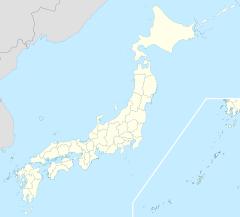Moro Station 毛呂駅 | |||||||||||
|---|---|---|---|---|---|---|---|---|---|---|---|
 The station entrance in May 2012 | |||||||||||
| Location | Iwai, Moroyama-cho, Iruma-gun, Saitama-shi Japan | ||||||||||
| Operated by | |||||||||||
| Line(s) | ■ Hachikō Line | ||||||||||
| Distance | 5.8 km from Komagawa | ||||||||||
| Platforms | 2 side platforms | ||||||||||
| Tracks | 2 | ||||||||||
| Connections | Bus stop | ||||||||||
| Other information | |||||||||||
| Website | www | ||||||||||
| History | |||||||||||
| Opened | 15 April 1933 | ||||||||||
| Passengers | |||||||||||
| FY2014 | 717 daily | ||||||||||
| Services | |||||||||||
| |||||||||||
| Location | |||||||||||
Moro Station (毛呂駅, Moro-eki) is a railway station on the Hachikō Line in the town of Moroyama, Saitama, Japan, operated by East Japan Railway Company (JR East).
Lines
Moro Station is served by the single-track Hachikō Line between Komagawa and Takasaki, and lies 5.8 km from the starting point of the Hachikō Line at Komagawa.[1]
Station layout
The station consists of two opposed side platforms serving two tracks, which form a passing loop on the single-track line. The station building is located on the west (northbound) side. The platforms are connected by a footbridge. A storage siding is located behind the southbound platform 1.
Platforms
| 1 | ■ Hachikō Line | for Komagawa |
| 2 | ■ Hachikō Line | for Ogawamachi, Yorii, and Takasaki |
History
The station opened on 15 April 1933.[1] With the privatization of Japanese National Railways (JNR) on 1 April 1987, the station came under the control of JR East.[1]
Passenger statistics
In fiscal 2014, the station was used by an average of 717 passengers daily (boarding passengers only).[2] The passenger figures for previous years are as shown below.
| Fiscal year | Daily average |
|---|---|
| 2000 | 905[3] |
| 2005 | 918[4] |
| 2010 | 738[5] |
| 2011 | 699[6] |
| 2014 | 717[2] |
Surrounding area
- Higashi-Moro Station (Tobu Ogose Line) (approximately 15 minutes' walk away)
- Saitama Medical School Moroyama Campus
- Moroyama Elementary School
- Moroyama Middle School
- Moroyama Town Hall
- Moroyama Post Office
- Moroyama Public Library
Bus services
Moro Station is served by the "Moro Bus" community minibus (Yuzu Yellow Line) service.[7]
See also
References
- ^ a b c Ishino, Tetsu, ed. (1998). 停車場変遷大辞典 国鉄・JR編 [Station Transition Directory – JNR/JR]. II. Japan: JTB. p. 199. ISBN 4-533-02980-9.
- ^ a b 各駅の乗車人員 (2012年度) [Station passenger statistics (Fiscal 2012)] (in Japanese). Japan: East Japan Railway Company. Retrieved 21 July 2013.
- ^ 各駅の乗車人員 (2000年度) [Station passenger figures (Fiscal 2000)] (in Japanese). Japan: East Japan Railway Company. Retrieved 21 July 2013.
- ^ 各駅の乗車人員 (2005年度) [Station passenger figures (Fiscal 2005)] (in Japanese). Japan: East Japan Railway Company. Archived from the original on 2 April 2019. Retrieved 21 July 2013.
- ^ 各駅の乗車人員 (2010年度) [Station passenger figures (Fiscal 2010)] (in Japanese). Japan: East Japan Railway Company. Retrieved 21 July 2013.
- ^ 各駅の乗車人員 (2011年度) [Station passenger figures (Fiscal 2010)] (in Japanese). Japan: East Japan Railway Company. Retrieved 21 July 2013.
- ^ もろバス時刻表 ゆず号 [Moro Bus Timetable – Yuzu] (PDF) (in Japanese). Japan: Moroyama. Archived from the original (PDF) on 15 December 2013. Retrieved 26 March 2013.
External links
- Moro Station information (JR East) (in Japanese)


